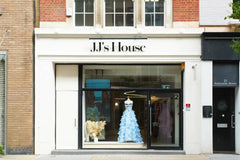Impacts of New EU Tariffs on Luxury Pricing and the Rise of Resale Markets
Table of Contents
- Key Highlights:
- Introduction
- The Tariff Landscape: An Overview
- Consumer Behavior Amidst Rising Prices
- Luxury Retailers Respond to Changing Dynamics
- The Future of Luxury Pricing
- Conclusion
Key Highlights:
- The U.S. has enacted a 15% tariff on most European imports, affecting luxury goods significantly.
- Although the tariff is lower than the initially proposed 30%, it is expected to raise prices for luxury retailers.
- The shift in pricing dynamics may accelerate the growth of the resale market as consumers seek alternatives.
Introduction
In a landscape where economic fluctuations and trade agreements can significantly influence market dynamics, the recent announcement of a 15% tariff on European imports by the United States has raised considerable concerns among luxury retailers. This move, effective from August 1, comes as a compromise compared to the previously threatened 30% tariff, but its implications for luxury pricing and the retail landscape are profound. As the luxury market grapples with these changes, the potential for rising prices could inadvertently fuel the growth of the resale market, altering consumer behavior and retail strategies.
The Tariff Landscape: An Overview
The framework for the new tariffs emerged from negotiations aimed at addressing trade imbalances between the United States and the European Union. While the decision to impose a 15% tariff may be seen as a victory for European negotiators, luxury brands must now navigate an uncertain future. The tariff applies to a broad range of goods, but luxury items, including high-end fashion and accessories, are likely to feel the most significant impact.
Economic Implications for Luxury Brands
Luxury retailers, known for their premium pricing strategies, may have to readjust their pricing structures in response to the added costs imposed by tariffs. A notable example is the iconic French brand Hermès, which has seen its products become synonymous with exclusivity and high price points. The new tariffs could necessitate price increases that might alienate some consumers while still appealing to their core customer base, who prioritize prestige over price.
However, the luxury market has historically shown resilience amid economic changes. For example, during previous economic downturns, luxury brands have often maintained their sales through strategic price adjustments and enhanced customer engagement. This suggests that while the immediate impact of the tariff is concerning, luxury brands may adapt to sustain their market position.
Consumer Behavior Amidst Rising Prices
For the affluent consumer, price sensitivity can vary dramatically. Some consumers may remain indifferent to slight price increases due to their financial capacity, while others may begin to reassess their purchasing habits. The luxury shopper's psychology often revolves around the perceived value of exclusivity and quality; thus, brands like Gucci and Louis Vuitton may find it easier to pass on price increases without significantly affecting demand.
Yet, as luxury goods become more expensive, alternative purchasing avenues, such as the resale market, gain traction. Platforms like The RealReal and Vestiaire Collective have seen increased consumer interest as shoppers seek to acquire luxury items at lower price points. This shift indicates a potential transformation in how luxury goods are consumed, with resale markets becoming a viable option for both sustainability-conscious consumers and budget-minded luxury enthusiasts.
The Resale Market: A Growing Trend
The rise of the resale market has been one of the most notable trends in recent years, driven by both economic factors and changing consumer values. As luxury items become more expensive due to tariffs, many consumers may turn to pre-owned goods as a cost-effective solution. The resale market allows consumers to access high-end products at a fraction of the original price, while also promoting sustainability through circular fashion practices.
Several key factors contribute to the growth of the resale market:
- Sustainability Concerns: As awareness of environmental issues grows, consumers are more inclined to purchase second-hand goods, reducing their carbon footprint and promoting sustainable fashion.
- Economic Constraints: With rising costs across various sectors, consumers are more budget-conscious, turning to resale as a way to indulge in luxury without overspending.
- Changing Attitudes Toward Ownership: Younger consumers, particularly millennials and Gen Z, are less focused on ownership and more interested in experiences. This shift often leads them to seek out unique, pre-owned luxury items rather than new, mass-produced goods.
Luxury Retailers Respond to Changing Dynamics
In light of the new tariff regime, luxury retailers must recalibrate their strategies to retain their customer base while adapting to shifting market conditions. Many brands are likely to explore several avenues:
Adjusting Pricing Strategies
Some luxury brands may choose to absorb the tariff costs to maintain customer loyalty. By implementing strategic pricing adjustments that do not significantly deter consumers, brands can navigate the complexities of the new tariff landscape more effectively. For instance, brands may offer limited-time promotions or exclusive collections that create a sense of urgency among consumers.
Enhancing Customer Experience
To offset potential declines in sales due to rising prices, luxury brands are increasingly focusing on enhancing customer experience. This may include personalized shopping experiences, exclusive access to events, or loyalty programs that reward repeat customers. By fostering a strong emotional connection with their clientele, luxury retailers can potentially mitigate the impact of price increases.
Expanding Resale Partnerships
Recognizing the growing importance of the resale market, luxury brands may also consider partnerships with reputable resale platforms. Collaborating with these platforms can help brands maintain control over their products while tapping into a new revenue stream. Additionally, such partnerships can enhance brand visibility among younger consumers who prioritize sustainability.
The Future of Luxury Pricing
As the luxury market adapts to the implications of the new tariffs, the interplay between traditional retail and resale markets will likely continue to evolve. The pricing strategies that luxury brands employ will not only determine their immediate financial outcomes but also their long-term brand positioning in a competitive landscape.
Potential Shifts in Brand Perception
Luxury brands must be cognizant of how their pricing decisions influence consumer perception. A brand that is perceived as excessively priced may lose its allure, particularly among younger consumers who value authenticity and social responsibility. By balancing luxury with accessibility, brands can maintain their exclusivity while appealing to a broader audience.
The Role of Technology
Technological advancements are also playing a crucial role in shaping the future of luxury retail. E-commerce platforms, augmented reality, and artificial intelligence are redefining the shopping experience, making it easier for consumers to discover and purchase luxury items. Brands that embrace these technologies can enhance customer engagement and streamline their operations, positioning themselves favorably in a rapidly changing market.
Conclusion
The recent imposition of tariffs on European luxury goods presents both challenges and opportunities for retailers in the sector. While price increases may initially deter some consumers, the continued allure of luxury brands, combined with the growth of the resale market, offers a pathway for adaptation and resilience. As the luxury landscape evolves, retailers will need to remain agile, embracing new strategies to navigate economic changes while meeting the demands of an increasingly discerning consumer base.
FAQ
Q: How will the new tariffs specifically affect luxury brands?
A: The tariffs are expected to increase prices on luxury goods, which may lead to a shift in consumer purchasing behavior and potentially drive interest towards resale markets.
Q: What are some examples of luxury brands likely to be affected?
A: High-end brands such as Hermès, Gucci, and Louis Vuitton are among those that may need to adjust their pricing strategies in response to the new tariffs.
Q: Why is the resale market growing?
A: The resale market is growing due to increased consumer interest in sustainability, economic factors prompting budget-conscious shopping, and changing attitudes towards luxury ownership.
Q: How can luxury brands adapt to these changes?
A: Brands can adjust pricing strategies, enhance customer experience, and explore partnerships with resale platforms to adapt to the new economic environment.
Q: What impact do tariffs have on consumer perception of luxury?
A: Rising prices due to tariffs can alter consumer perception, potentially leading to a demand for more accessible luxury options or pre-owned goods if new items are seen as overly expensive.
Power your ecommerce with our weekly insights and updates!
Hold deg oppdatert på hva som skjer i handelsverdenen
E-postadresse





